By Jeffrey A. Rendall; Photos Courtesy of the USGA
PINEHURST, NC – Thank God for Michael Campbell.
Just when the 2005 US Open, America’s National Championship, was on the verge of devolving into a re-run of the 2002 Masters (one of the biggest fold-jobs in history), Campbell rose to the challenge and saved the day.
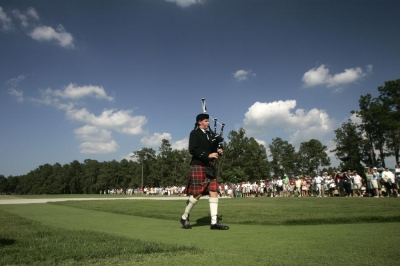 |
| The 2005 US Open began with a special tribute to '99 winner, Payne Stewart. Pinehurst will never forget him, and neither will we. |
For those with short memories, the 2002 Masters was literally handed to Tiger Woods when all competitors wilted like azalea blossoms in the Sahara Desert once Woods stepped onto the tee. And for half the day on Sunday at the US Open, it appeared a repeat performance was in order, with Woods’ name slowly creeping up the leader-board (after starting the day six shots behind) and all challengers grasping for the nearest oxygen mask after each deafening roar. Or should I say, a pine tree to hide under.
Everyone except Michael Campbell, that is. Remembering back to the 1995 British Open, it seemed a strong possibility the New Zealander would succumb once again to the immense pressures that major tournaments inflict. After all, New Zealand is famous for producing rough and tumble rugby players, not steadfast golfers.
There was a great deal of drama, as nearly every major championship tends to provide. But was it great golf? That’s a debatable question.
We won’t delve into the stroke-to-stroke results of the tournament – that’s been well covered by our colleagues in the major print publications, as well as on TV by NBC and the Golf Channel (and ESPN), all of which did superb jobs in presenting the follow-up acts to the historic 1999 Open, won by tragic character Payne Stewart.
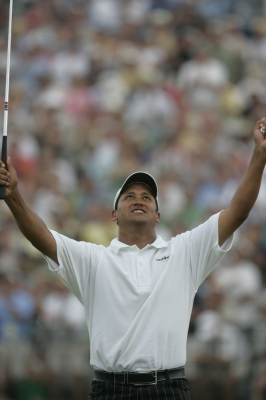 |
| Michael Campbell raises his arms in triumph after rolling in his final putt. He said afterwards that he 'deserved' victory, and he was right. |
But we will offer some behind-the-ropes observations garnered from attending our first Major Championship:
What Makes Majors Different?
It was a study in contrast, attending the ‘Open a week after covering our Washington area’s Booz Allen Classic. The venues were both worthy, the fields were similar and there was a lot of money at stake in both cases.
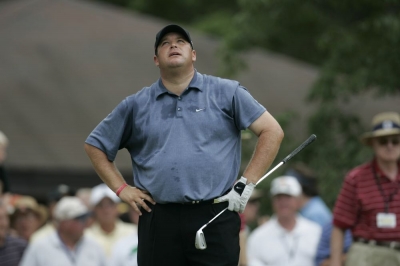 |
| Nationwide Tour player Jason Gore was the 'Cinderella' story of the '05 Open, but his Sunday collapse certainly softened what could've been a terrific conclusion. |
But the US Open’s a major, and therefore, in a different league altogether.
The first noticeable difference is the gallery is about twice as large (or it seems like it). The grandstands are packed, and most viewing areas near tees and greens – and even in the fairways – were about three-deep with spectators. The energy is in the air, it’s hard to describe. The people were there to watch golf (and were knowledgeable), which is not always the case at the regular tournaments.
If you’re looking for a pure tournament experience, your local PGA Tour event will probably provide it to a higher degree. You’ll certainly be able to see a lot more, and you can even follow most groups without too much impeding you. Forget that idea at the ‘Open, even for pairings without big names. The tees and greens are packed with folks who’ve already set up camp for the day, reserving the prime viewing spots for when the ‘stars’ eventually come through.
Simply put, it’s a lot more difficult to tell what’s going on at the major events. But then again, it is the US Open – a chance to observe history you won’t receive very often.
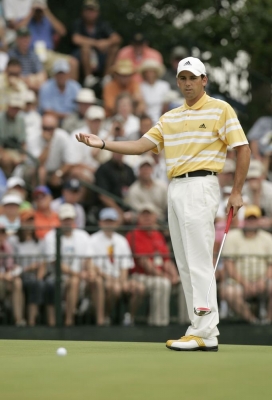 |
| Sergio Garcia wonders what happened on this putt. His bewilderment was shared by everyone else in the field. Pinehurst's greens won the Open, and Donald Ross is smiling down from above. |
Tiger’s the Axis
Arriving at a spot near a green, tee, or fairway landing area, the patrons invariably measure the progress of the field by one yardstick – the position of the current group in relation to Tiger’s.
“We’ve got three more groups until Tiger will be here,” I heard several people say.
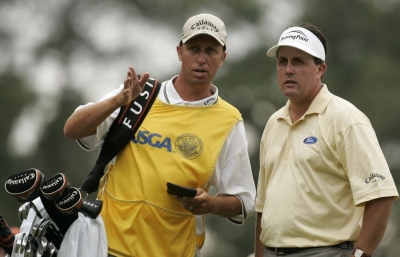 |
| Phil Mickelson consults with caddy Jim 'Bones' MacKay during Friday's round. Mickelson shot an opening round 69, but unfortunately never contended after that. |
It didn’t matter whether Tiger was on the lead or several groups in front, the gallery plans its day largely depending on where the ‘star’ happens to be at any one time.
You’ve got your pockets of Phil Mickelson fans, John Daly supporters and Fred Funk fanatics, but there’s nothing like the ‘cult’ of Tiger Woods when it comes to group mentality.
The ‘Hot Head’ Trend
Seeing as most fans want to see Tiger -- in some ways, one wonders why. Sure, Tiger’s the number one ranked player in the world, possesses the greatest talent every time he competes, and can recover from spots that no other player would even consider. Not only is he the best player, he’s the most exciting to watch as well.
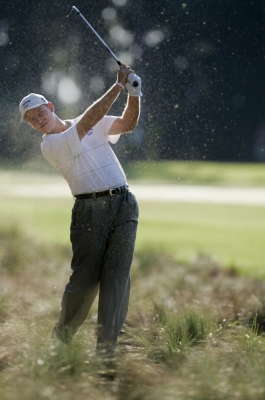 |
| Ernie Els hits from a bad spot. Els quietly finished in a tie for 15th, yet was never a threat to make any noise, whatsoever. |
But despite nearly a decade of seasoning on Tour, Tiger still exhibits an extraordinary amount of spoiled brat behavior on the golf course. He slams and throws clubs, pouts after a particularly poor shot and utters more oaths than a ship full of sailors on holiday after a lengthy tour at sea.
My kids weren’t at the Open, but one wonders what it’s like to idolize a player of Tiger’s caliber, only to witness the surprising displays of poor sportsmanship that he exhibits during a tournament. On Friday at the ‘Open, after missing a putt he even raked his putter across the 9th green – then made a pathetically lame attempt to fix the damage he’d done.
You can’t help but admire Tiger’s fierce competitive nature, but he’s got a long ways to go before becoming a true ambassador of the game, in the mold of past legends such as Bobby Jones, Sam Snead and Arnold Palmer. Tiger may very well break all the records, but many fans will not remember him in the exalted way he could be thought of, if he’d only take some charm lessons.
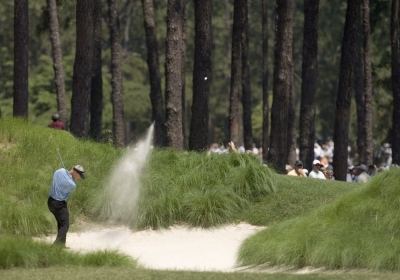 |
| Corey Pavin blasts out of a bunker. Pinehurst's set-up managed to penalize just about everyone, but a master shot-maker like Pavin still managed a tie for 11th. |
Following Tiger’s lead is a new generation of ‘hot head’ players – seems as if it’s ‘cool’ to act like a tantrum-throwing junior player in front of tens of thousands of fans. Rory Sabbatini lost it last week at the Booz Allen Classic, and you would’ve thought he’d learned. But the steam was still coming out of his ears at the US Open, showing outright anger at every bad bounce of the ball.
Pat Perez (who wasn’t at the Open) is similarly notorious for his club-breaking incident at Pebble Beach, and he’s attracted ‘human interest’ stories detailing his on-going battle with his temper – only to declare that ‘it’s the way I am,’ and if he holds it in, he doesn’t play as well.
Now there’s one of the new potential stars on Tour, Spencer Levin (who was at the Open), who’s already earning a reputation as a ‘hot head.’ He too declares that he’s not going to change – why should he? It only seems to get you noticed. Exposure equals money, a sad commentary.
Didn’t they teach these guys in Little League that throwing the bat gets you tossed out of the game?
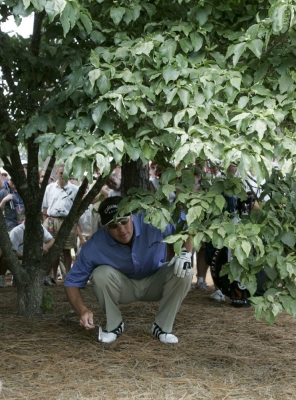 |
| Brandt Jobe briefly held the lead during the opening round, but got himself in some tough spots on his way to finishing in a tie for 33rd. |
There’s little excuse for it. Tiger and his temperamental contemporaries are not the beer drinking bozos you’ll see every Saturday on your local muni, cussing mercilessly and throwing clubs like the hammer toss in the last Olympic Games. They’re the leaders in the sport, and we all should expect – and demand -- more from them.
Everyone gets mad on a golf course, and most of us are known for some profane words – but it’d be different if there were galleries watching our every move instead of trees and bushes. That’s common courtesy, when ladies and kids are around.
Seeing the coverage on Sunday, even Johnny Miller was remiss to note as Tiger uttered yet another collection of f-bombs in front of the entire world. If golf’s a gentleman’s game, and Tiger’s the symbol for it, then he needs to find a way to maintain the competitive edge and grow up a bit at the same time. Ditto for the rest of the ‘hot head’ contingent.
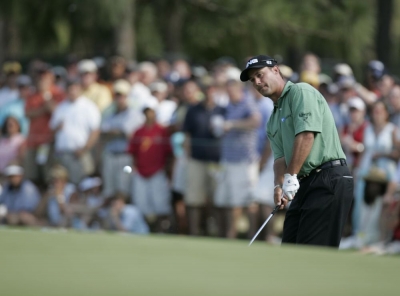 |
| Chris DiMarco was one of the pre-tournament favorites, but couldn't get it going and missed the cut. |
It’s no less noticeable in person, and one observer, at least, is tired of it.
Club Carrier or Enforcer?
Tiger’s bad boy image is only enhanced by his caddy, Steve Williams. Williams clearly sees it as his job to ensure that poor little Tiger isn’t overly distracted by the thousands of adoring fans that track his every step on the golf course.
Williams relentlessly scans the ropes in search of cameras or any other potential noise-making devices, and isn’t shy about barking commands to fans to conform or face the same type of wrath that others have suffered in the past.
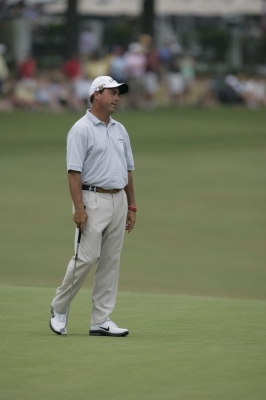 |
| Olin Browne played in the final group on Saturday, and with Campbell on Sunday. The course eventually caught up with him, however. But his good humor and gentlemanly play certainly impressed the gallery. |
Tiger fired ‘Fluff’ Cowan many years ago because he didn’t feel the Tour veteran caddy was ‘professional’ enough for him. He found Steve Williams, the zero-sum Kiwi who scowls at people and turns the stomach of just about every true golf fan in attendance. Perhaps it’s a perfect personality match.
Is this golf or pro wrestling?
One can only conclude that fans must eat it up, as Tiger remains the chief draw amongst the faithful – on TV and in person. It’s hard to believe, in this fan’s estimation.
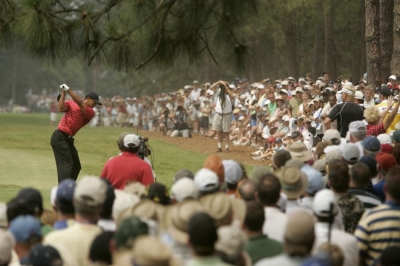 |
| The crowds were big and deep for Tiger Woods all week. The 'Cult of Tiger Woods' is evident everywhere he goes. |
No one doubts it’s difficult to be Tiger – his popularity breeds the type of problems that only someone like Williams sees fit to handle. But if Tiger’s truly the strongest mental competitor, then perhaps his public image as a ‘hot head’ would cool if his caddy would tone it down a bit. Basic people skills aren’t too much to ask for, Steve – especially when those ‘people’ are on your side.
US Open Set-Ups – Fun To Watch?
Witnessing the action late on Saturday, before Retief Goosen recovered to birdie three of his last five holes, there wasn’t a single red number on the leader board. Nobody under par for the tournament, nobody under par for the day (Peter Jacobsen shot a one-under 69, but he wasn’t on the board).
In other words, there wasn’t a whole lot of positive movement until the very end of the day’s round. No dramatic moves and no charges, just a whole lot of ‘holding on’ by every player near the lead.
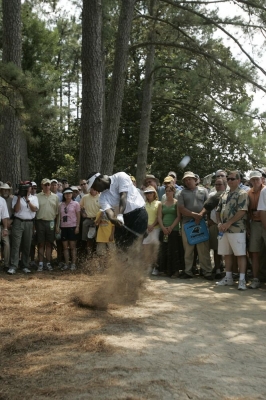 |
| Can you say it's disappointing to tie for 6th in the US Open? It is when you're Vijay Singh. Here's wishing he would've made a go of it on Sunday, along with several of his cohorts. |
Sunday was no different, as Woods and Campbell were the only ones who actually made up ground.
We appreciate the USGA’s never-ending pursuit of par as the standard of excellence in the US Open. But as a fan, observing a bunch of professional players just hoping to avoid bogeys does not make for an exciting way to watch golf. A dramatic par save is just as exciting as a birdie, but observing putt after putt missed to result in bogey is a bit monotonous.
In contrast, the Masters has found a way to inject some excitement into the game without making the set-up so difficult that the tournament loses its excitement. The USGA, to its credit, didn’t lose control of the playing conditions in 2005 (like it has in the past). But it’s possible to go even a little further, where even several players with good days might be able to shoot some good scores.
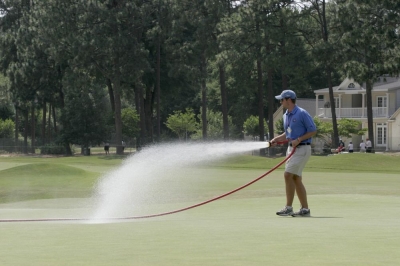 |
| The USGA was determined not to let Pinehurst #2 get away from it. Here's part of the reason why players loved the layout and the conditions. |
Or why not simply allow the courses to play to a par of 72? Lengthen a couple of the beastly long par fours a bit, squeeze the fairways to a minimum and give the players a couple birdie holes on the card. I can’t see how it would hurt the tournament (since the final scores would be the same), yet it would definitely give fans, and the players, something to look forward to – and something to cheer for as well.
What difference does it make that Campbell would have won with a score of 8-under 270 as opposed to Even Par 270? Every hack in the world can make bogeys – the average fan wants to see some of these guys beat par. That’s what a professional should do, after all.
Goin’ To Pinehurst
Having played Pinehurst #2 in the past, it was a real thrill to see golf’s greatest players shooting from the same tee boxes, hitting out of the same bunkers and putting those same impossible greens. A few even hit off the same pine straw that became my best friend the day I took on the legendary course.
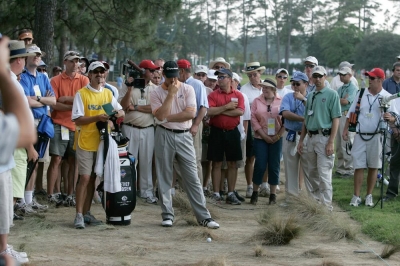 |
| Retief Goosen took a three shot lead into Sunday's round. More than one observer thought it was over (myself included). His final round 81 took care of the questions, and he finally admitted 'it's just a game.' A gentleman to the end, there's no shame in being a two-time US Open champ. Way to go, Retief. |
The USGA (again, here’s some credit) has hit on a great thing, bringing the ‘Open to a public access course – one with a virtually unparalleled reputation, and one that is open to everyone (if they can afford the fee).
There’s just something that’s extra special about that – making the course and the game ‘belong’ to the fans just a little more.
Congratulations to USGA for holding a terrific sporting event, and to Michael Campbell for displaying the guts to make the 2005 US Open memorable for something other than a series of historic failures. It wasn’t quite the same as 1999, but then again, there hasn’t been a tournament since (maybe with the possible exception of the 2004 Masters) with a similarly spectacular storyline.
Note: Our thanks to Craig Smith and the folks at the USGA for their invitation to be part of the 2005 US Open.
Details:
The 2005
Pinehurst Course 2, June 12 – 19, 2005
Winner: Michael Campbell. Score: 280. Winner’s Share: $1,170,000. Total Purse: $6.5 million.
| Related Links | Comments on this article? | |
|
Maryland National Golf Club Hollow Creek Golf Club Rocky Gap Resort PB Dye Golf Club in Ijamsville Whiskey Creek Golf Club |
E-mail Jeff Rendall, Editor: jrendall@golftheunitedstates.com |











